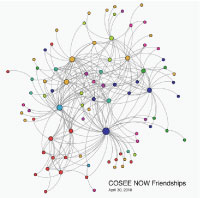COSEE NOW continues to work toward its goals of enabling the use of cutting edge ocean research and fostering partnerships among scientists and educators, especially those working in the ocean observing systems community. During the past year, COSEE NOW has re-launched its website, conducted online seminars for scientists and educators, and developed a suite of educational resources for formal and informal education settings. Intrigued? See the highlights below for more detail.
 |
Snapshot of the COSEE NOW
website friendship relationships
as a network diagram |
COSEE NOW Goes Social
In April 2010, we launched the third major revision to the COSEE NOW website. While previous versions provided limited community interactions (i.e., user comments on posted resources), this new version greatly expands the collaborative abilities of our members. As of early July 2010, the COSEE NOW website has 299 registered users. Those users have initiated 293 friendship requests, of which 185 have been confirmed by the receiving party. Key features of the new site include:
- Enhanced profiles that make it easier for users to search for colleagues and potential collaborators with common interests.
- Allowing users to “friend” each other and develop their own network of peers while also customizing their RSS feed to focus on their friends’ activities.
- The inclusion of topical workgroups (public and private), where users can participate in forum discussions, share resources, send email alerts of notable news, and (if desired by the group’s peer leaders) create a group blog.
- Community blogs that are topical or event-based and focus community discussions on subjects and resources relevant to specific sub-interests, including broader impacts and ocean observatory education.
- And of course, the site continues to feature a growing list of great resources from the NOW team, including educational activities, multimedia resources, surveys and effective practice guides.
Learning From Afar
From May 2009 through June 2010, COSEE NOW conducted or hosted 24 webinars and web-based meetings. Each webinar lasted about an hour and most were part of a 3- or 4-session series that offered multiple perspectives on a particular topic of interest to science researchers and/or science educators. COSEE NOW targeted four important COSEE audiences including 1) scientists wishing to improve their response to NSF Criterion II for Broader Impacts, 2) educators and scientists associated with the Integrated Ocean Observing Systems (IOOS) network, 3) formal and informal educators interested in developing or expanding their use of real time data from OOS with students and families visiting informal science centers and aquaria, and 4) informal educators associated with 4-H Youth Development. Based on evaluation data, we have improved with each webinar and have developed a list of “best practices” for using this online technique. With each additional workshop COSEE NOW continues to learn from and refine its technique at orchestrating these online conferences.
Ocean Gazing
COSEE NOW continues to work towards bringing science and scientists to the public through Ari Daniel Shapiro’s biweekly podcast,
Ocean Gazing. As of early July 2010, Ari has produced and posted 37 unique episodes, which capture the personal stories of scientists and their work. Scientists have said that they enjoy participating in the podcast as it allows them to make their science accessible and promote their work in an engaging and accurate manner.
The first 26 podcast episodes were matched to classroom lesson plans and we now have a CD-ROM entitled Ocean Gazing: Volume 1. This makes the podcasts more relevant to classrooms and serves as an example of education and outreach that other ocean scientists could consider using in their own work.
Science Research in Schools
Members of COSEE NOW are designing a weeklong teacher’s institute as part of the NSF-funded project Collaborative Research: Modified Circumpolar Deep Water Intrusions as an Iron Source to the Summer Ross Sea Ecosystem. To be held in August 2010, the institute will familiarize 25 middle school earth science teachers with the science of the Antarctica and techniques for communicating it to their students. The workshop will include data-based lessons on the use of Slocum Gliders and Antarctic research. It will also introduce the concepts of storytelling and photography to enhance scientific study and reporting and provide multi-disciplinary examples that teachers can use with their students. The teachers and students will participate in live audio casts from the research vessel while it is in Antarctic waters in January 2011 via webinar technology and infrastructure developed by the COSEE NOW team.
COSEE NOW members continue with the pilot MATE’s Ocean Drifter Project. The goal of this project is to incorporate ocean technology, real-time data collection, and data sharing into the community college curriculum. Currently 13 faculty around the country are participating. Drifter data and activities have been incorporated into 19 different courses (oceanography, remote sensing/GIS, marine biology, coastal science, marine electronics, geography, vessel operations, field sampling, data processing, marine instrumentation and robotics). All data are accessible through NOAA’s drifter website.
COSEE NOW Tidbits
- Liberty Science Center staff presented Exploring the Ocean with Robots, a demonstration on buoyancy and real time data collection at the Smithsonian Museum of Natural History, as part of a Rutgers University contingent celebrating the Scarlet Knight cross-Atlantic mission and the presentation of a glider for display within the Smithsonian.
- Christopher Petrone authored an article on the Bridge/COSEE NOW classroom data activity Don’t Even Sink About It!
- Janice McDonnell authored an article on COSEE NOW for a special edition of The Earth Scientist (Volume XXVI, Issue 1, Spring 2010), the quarterly journal of the National Earth Science Teachers Association (NESTA).
- COSEE NOW staff presented and disseminated COSEE NOW materials at workshops held during the Marine Technology Society (MTS) meetings on October 26–29, 2009, in Biloxi, MS and the National Science Teachers Association (NSTA) meeting March 18 – 21, 2010 in Philadelphia, PA.
To keep up with what NOW is doing next, visit COSEE NOW!

